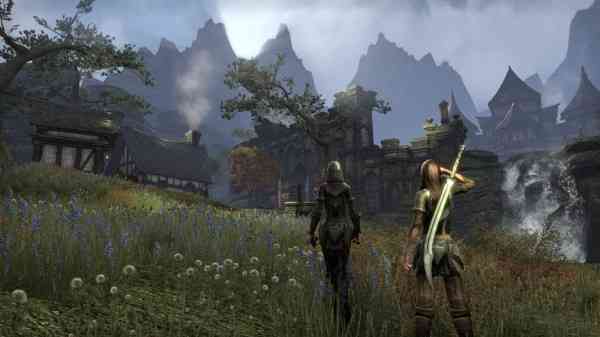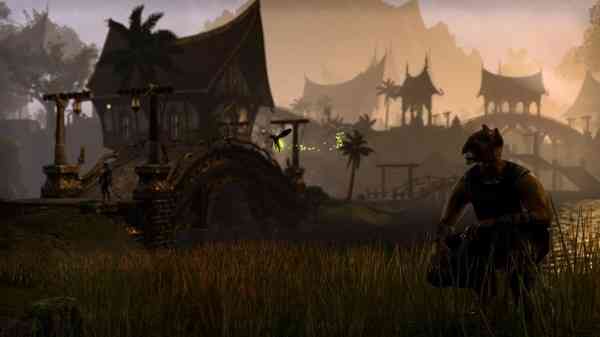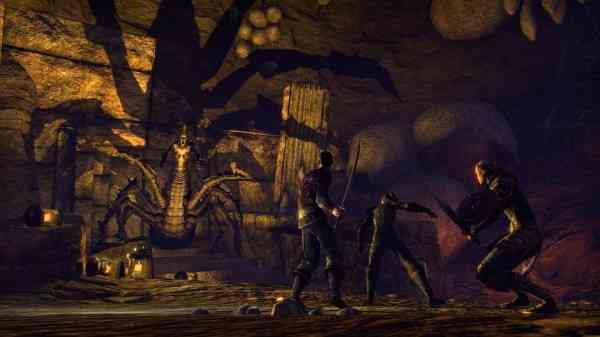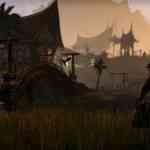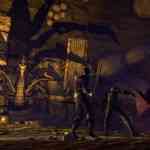The team at Bethesda has a pedigree that is nearly unmatched in the RPG space. The Elder Scrolls series is near universally praised, as are the Fallout games. They all share a common premise: create a character, and then go. Where? It doesn’t matter. You’re guaranteed to run into something no matter where you go, all of it fully voiced and woven into the world’s lore. Frankly, it’s incredible. Skyrim continues to be one of the most buzzed about games in social circles like Reddit, and spawned an enormous modding community. Instead of continuing that formula, Zenimax and Bethesda have taken an abrupt turn. Or have they?
I’ve been playing The Elder Scrolls Online to find out.
What’s the same?
If my short time with the game is truly representative, lots. It plays almost identically to its predecessors. As always, you begin as a nameless prisoner. I’ll spare the details to protect the storyline, but suffice to say you’ll need to escape prison once again before being set loose in Tamriel. After that, you’ll receive some guidance from key characters, but are generally free to spelunk at your leisure.
Once out in the world, the game feels very much like past Elder Scrolls titles. I played mostly from a first person perspective, and set out from Khenarthi’s Roost in search of trouble. It didn’t take long to come across some familiar quest structures: Moon Sugar farmers with rat trouble, a Dominion officer missing her crew after a storm, a political murder mystery. It felt like running into an old friend, and it didn’t take long for me to utterly abandon the main quest line in favour of exploring – just how an Elder Scrolls game should be.
If you like how Skyrim played, you’re in for a treat. Yep, ESO plays very much like Skyrim from a combat perspective. They’ve added a handy skill bar so spell casting is more streamlined – and it makes you feel like a badass. The ability to run into battle raining fireballs from the sky while throwing magical javelins and using a frost staff is snazzy. It makes combat interesting, even when you’re wading through hordes of Skeevers.
ESO also looks nice – not Skyrim with 150 mods nice, but definitely shiny enough to elicit some ooohs and aaahs. The areas I played through exhibited unique personality too. More exciting was the sound design – it has always been a strong point of Bethesda games, but ESO steps things up dramatically through high quality voice acting. The list of big name talent is impressive, and I easily recognized John Cleese, Malcolm McDowell, Michael Gambon, and Jennifer Hale without knowing they were in there. Turns out Bill Nighy, Alfred Molina, and Kate Beckinsale are somewhere in Tamriel as well. The voice acting is universally a home run, with each actor turning in a solid performance – even the nameless NPCs sound better to my ears.
What’s changed?
To coin a phrase, a healthy dose of MMO-ness. There are 3 factions in the game: the Ebonheart Pact, the Daggerfall Covenant, and the Aldmeri Dominion, which my High Elf fell under. Interestingly the factions are tied to specific races, but what role the factions play did not become clear during my time online. There are 4 classes to choose from as well: Dragonknight, Sorcerer, Templar, and Nightblade. The first three essentially fill the traditional MMO roles of tank, DPS, and healer, while the Nightblade is a sneaky wildcard (though there appears to be no pickpocketing or stealing in the game). This is decidedly more narrow than the myriad class options in Skyrim, but thankfully classes serve only as a base, and any character can master any profession (such as Alchemy) given enough dedication.
Then there are a number of changes that fall clearly under the category ‘necessity’. For example, like all MMOs, life bars tend to refill themselves quickly once battle is finished, and quest givers are generally locked to a certain spot on the ground. To have things any other way could mess up the experience in untold ways once the servers are packed full. I understand why some changes are present, but some of them break the immersion for me.
It’s always bothered me when a game claims that you are unique, and the protector of all things, and there’s a special bond between the you and the gods… And there are 57 other characters standing in the same spot getting the same dialogue from an NPC. OR you need to seal the demons into the underworld by activating a sphere of light, but first you have to wait for the sphere to reset. It’s unavoidable of course, but it detracts from my enjoyment of the game.
The level design has been altered compared to standard Elder Scrolls maps – it’s obvious that areas have been designed to hold a huge number of characters at a time. Spaces feel more open, with a large amount of flat surface. It allows for more epic battles to play out involving big groups of players, but I definitely noticed the change in ‘map feel’ compared to Oblivion or Skyrim.
One positive change is the ability to group up and take on tougher challenges. Unfortunately I didn’t have much success grouping up during the media beta thanks to the size of the world, but I did manage to use other players as decoys a few times.
So What?
It’s good. I thoroughly enjoyed my time in The Elder Scrolls Online. Sure, things have changed a fair bit to accommodate the massively multiplayer structure, but the fundamentals that drain hundreds of hours of people’s lives are intact in ESO. In fact, the social aspects of the game might make it even more of a time sink than fans ever thought possible. Can Bethesda roll out enough content to justify the monthly fee? Will MMO fans be drawn into the world of Tamriel? We’re going to find out on April 4th.
